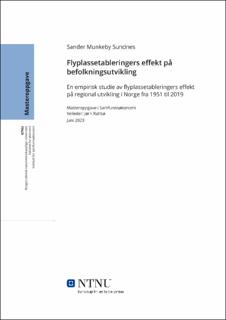| dc.contributor.advisor | Rattsø, Jørn. | |
| dc.contributor.author | Sundnes, Sander Munkeby. | |
| dc.date.accessioned | 2023-07-05T17:20:10Z | |
| dc.date.available | 2023-07-05T17:20:10Z | |
| dc.date.issued | 2023 | |
| dc.identifier | no.ntnu:inspera:145364976:46053707 | |
| dc.identifier.uri | https://hdl.handle.net/11250/3076322 | |
| dc.description.abstract | I denne oppgaven undersøkes det hvilken effekt etablering av flyplasser har på befolkningsutviklingen i regionene flyplassene opprettes i. Datamaterialet som legger grunnlaget for analysen og oppgaven som helhet er et paneldatasett som viser observasjoner på bo- og arbeidsmarkedsregioner i perioden 1951-2019. Analysen sentreres nærmere rundt den kausale effekten av å etablere flyplasser i en bo- og arbeidsmarkedsregion med hensyn på befolkningsutviklingen i den gitte regionen. Derfor benyttes følgelig en difference-in-differences-metode for å analysere hvordan befolkningsutviklingen endrer seg som følge av en flyplassetablering. Hvilke flyplasser og regioner det fokuseres på belyses i større grad i andre deler av oppgaven. Flyplassetableringene som det i første omgang fokuseres på, fant sted i begynnelsen av 1970-tallet.
Omsider utvides DiD-modellen med både årseffekter, ekstra kontrollgruppe og FE-modeller. Deretter utvides analysen videre for å studere om motivene bak flyplassetableringene har noen innvirkning på effekten av flyplassetableringer. Avslutningsvis i oppgaven gjentas DiD-modellene, FE-modellene og undergruppe-analysene med en ny behandlingsgruppe. Dette utgjør følgelig oppgavens robusthetsanalyse.
Resultatet av analysen indikerer en positiv effekt av flyplassetableringer med hensyn på befolkningsutviklingen i de regionene som etablerer flyplass. Resultatene er særlig klare og signifikante for de regionene som observerte positiv befolkningsutvikling i forkant av etableringene. For regioner med negativ befolkningsutvikling i forkant av flyplassetableringene fremstår resultatene mer tvetydig. | |
| dc.description.abstract | This thesis examines the effect airport-establishments has on population development in the regions in which the airports are established. The data that forms the basis of the analysis and the thesis, is a panel data set which shows observations on housing and labour market regions in the period between 1951-2019. The analysis centres more closely around the causal effect of establishing airports in a housing and labour market region with regards to population development in the region. Therefore, a difference-in-differences method is used to analyse how population development changes as a result of an airport establishment. The airports and regions which are focused upon are highlighted to a greater extent in other parts of the thesis, however the airport establishments that are firstly focused upon took place at the beginning of the 1970s.
Eventually, the DiD model is expanded with both year fixed effects, an additional control group and FE models. The analysis is then further extended to study whether the motives behind the airport establishments have any impact on the effect of airport establishments. At last, the DiD models, the FE models and the subgroup analyses are repeated with regards to a new treatment group. This extension further constitutes the thesis´ robustness analysis.
The result of the analysis indicates a positive effect of airport establishments with regards to population development in the regions that establish an airport. The results are particularly clear and significant for those regions that observe positive population growth ahead of the establishments. As for regions with negative population development ahead of the airport establishments, on the contrary, the results appear more ambiguous. | |
| dc.language | nob | |
| dc.publisher | NTNU | |
| dc.title | Flyplassetableringers effekt på befolkningsutvikling | |
| dc.type | Master thesis | |
